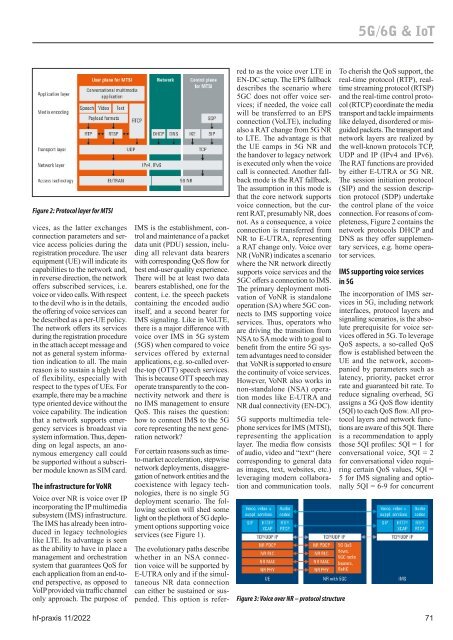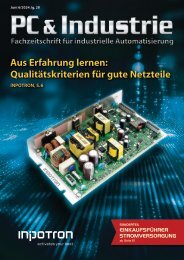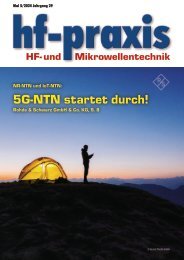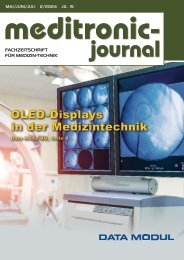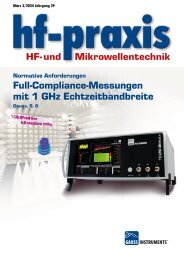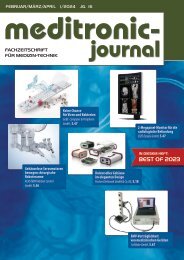11-2022
Fachzeitschrift für Hochfrequenz- und Mikrowellentechnik
Fachzeitschrift für Hochfrequenz- und Mikrowellentechnik
Sie wollen auch ein ePaper? Erhöhen Sie die Reichweite Ihrer Titel.
YUMPU macht aus Druck-PDFs automatisch weboptimierte ePaper, die Google liebt.
5G/6G & IoT<br />
Figure 2: Protocol layer for MTSI<br />
vices, as the latter exchanges<br />
connection parameters and service<br />
access policies during the<br />
registration procedure. The user<br />
equipment (UE) will indicate its<br />
capabilities to the network and,<br />
in reverse direction, the network<br />
offers subscribed services, i.e.<br />
voice or video calls. With respect<br />
to the devil who is in the details,<br />
the offering of voice services can<br />
be described as a per-UE policy.<br />
The network offers its services<br />
during the registration procedure<br />
in the attach accept message and<br />
not as general system information<br />
indication to all. The main<br />
reason is to sustain a high level<br />
of flexibility, especially with<br />
respect to the types of UEs. For<br />
example, there may be a machine<br />
type oriented device without the<br />
voice capability. The indication<br />
that a network supports emergency<br />
services is broadcast via<br />
system information. Thus, depending<br />
on legal aspects, an anonymous<br />
emergency call could<br />
be supported without a subscriber<br />
module known as SIM card.<br />
The infrastructure for VoNR<br />
Voice over NR is voice over IP<br />
incorporating the IP multimedia<br />
subsystem (IMS) infrastructure.<br />
The IMS has already been introduced<br />
in legacy technologies<br />
like LTE. Its advantage is seen<br />
as the ability to have in place a<br />
management and orchestration<br />
system that guarantees QoS for<br />
each application from an end-toend<br />
perspective, as opposed to<br />
VoIP provided via traffic channel<br />
only approach. The purpose of<br />
IMS is the establishment, control<br />
and maintenance of a packet<br />
data unit (PDU) session, including<br />
all relevant data bearers<br />
with corresponding QoS flow for<br />
best end-user quality experience.<br />
There will be at least two data<br />
bearers established, one for the<br />
content, i.e. the speech packets<br />
containing the encoded audio<br />
itself, and a second bearer for<br />
IMS signaling. Like in VoLTE,<br />
there is a major difference with<br />
voice over IMS in 5G system<br />
(5GS) when compared to voice<br />
services offered by external<br />
applications, e.g. so-called overthe-top<br />
(OTT) speech services.<br />
This is because OTT speech may<br />
operate transparently to the connectivity<br />
network and there is<br />
no IMS management to ensure<br />
QoS. This raises the question:<br />
how to connect IMS to the 5G<br />
core representing the next generation<br />
network?<br />
For certain reasons such as timeto-market<br />
acceleration, stepwise<br />
network deployments, disaggregation<br />
of network entities and the<br />
coexistence with legacy technologies,<br />
there is no single 5G<br />
deployment scenario. The following<br />
section will shed some<br />
light on the plethora of 5G deployment<br />
options supporting voice<br />
services (see Figure 1).<br />
The evolutionary paths describe<br />
whether in an NSA connection<br />
voice will be supported by<br />
E-UTRA only and if the simultaneous<br />
NR data connection<br />
can either be sustained or suspended.<br />
This option is referred<br />
to as the voice over LTE in<br />
EN-DC setup. The EPS fallback<br />
describes the scenario where<br />
5GC does not offer voice services;<br />
if needed, the voice call<br />
will be transferred to an EPS<br />
connection (VoLTE), including<br />
also a RAT change from 5G NR<br />
to LTE. The advantage is that<br />
the UE camps in 5G NR and<br />
the handover to legacy network<br />
is executed only when the voice<br />
call is connected. Another fallback<br />
mode is the RAT fallback.<br />
The assumption in this mode is<br />
that the core network supports<br />
voice connection, but the current<br />
RAT, presumably NR, does<br />
not. As a consequence, a voice<br />
connection is transferred from<br />
NR to E-UTRA, representing<br />
a RAT change only. Voice over<br />
NR (VoNR) indicates a scenario<br />
where the NR network directly<br />
supports voice services and the<br />
5GC offers a connection to IMS.<br />
The primary deployment motivation<br />
of VoNR is standalone<br />
operation (SA) where 5GC connects<br />
to IMS supporting voice<br />
services. Thus, operators who<br />
are driving the transition from<br />
NSA to SA mode with to goal to<br />
benefit from the entire 5G system<br />
advantages need to consider<br />
that VoNR is supported to ensure<br />
the continuity of voice services.<br />
However, VoNR also works in<br />
non-standalone (NSA) operation<br />
modes like E-UTRA and<br />
NR dual connectivity (EN-DC).<br />
5G supports multimedia telephone<br />
services for IMS (MTSI),<br />
representing the application<br />
layer. The media flow consists<br />
of audio, video and “text“ (here<br />
corresponding to general data<br />
as images, text, websites, etc.)<br />
leveraging modern collaboration<br />
and communication tools.<br />
Figure 3: Voice over NR – protocol structure<br />
To cherish the QoS support, the<br />
real-time protocol (RTP), realtime<br />
streaming protocol (RTSP)<br />
and the real-time control protocol<br />
(RTCP) coordinate the media<br />
transport and tackle impairments<br />
like delayed, disordered or misguided<br />
packets. The transport and<br />
network layers are realized by<br />
the well-known protocols TCP,<br />
UDP and IP (IPv4 and IPv6).<br />
The RAT functions are provided<br />
by either E-UTRA or 5G NR.<br />
The session initiation protocol<br />
(SIP) and the session description<br />
protocol (SDP) undertake<br />
the control plane of the voice<br />
connection. For reasons of completeness,<br />
Figure 2 contains the<br />
network protocols DHCP and<br />
DNS as they offer supplementary<br />
services, e.g. home operator<br />
services.<br />
IMS supporting voice services<br />
in 5G<br />
The incorporation of IMS services<br />
in 5G, including network<br />
interfaces, protocol layers and<br />
signaling scenarios, is the absolute<br />
prerequisite for voice services<br />
offered in 5G. To leverage<br />
QoS aspects, a so-called QoS<br />
flow is established between the<br />
UE and the network, accompanied<br />
by parameters such as<br />
latency, priority, packet error<br />
rate and guaranteed bit rate. To<br />
reduce signaling overhead, 5G<br />
assigns a 5G QoS flow identity<br />
(5QI) to each QoS flow. All protocol<br />
layers and network functions<br />
are aware of this 5QI. There<br />
is a recommendation to apply<br />
those 5QI profiles: 5QI = 1 for<br />
conversational voice, 5QI = 2<br />
for conversational video requiring<br />
certain QoS values, 5QI =<br />
5 for IMS signaling and optionally<br />
5QI = 6-9 for concurrent<br />
hf-praxis <strong>11</strong>/<strong>2022</strong> 71


